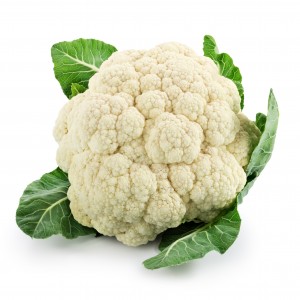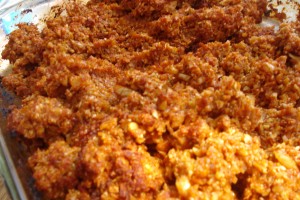Encouraged by my most recent attempt at using cauliflower for a rice substitute, I continued my efforts this weekend with yet another rice recipe. While I suspect a similar cooking method to what I used with the Mexican “Rice” would work here, too, I wanted to try keeping the cauliflower raw this time. Due to my recent increase in vegetable consumption, I have discovered that I enjoy more and more vegetables raw or simply warmed to eating temperature, rather than cooked through. I wanted to see if cauliflower “rice” might below to the same category.
It had been quite some time since I’d made Indian-style curries for myself at home, so I resolved to make two favorites from my recipe box this weekend: Chicken Tikka Masala and Saag (Indian Creamed Spinach). What better opportunity to try out another Cauliflower “Rice” recipe than as a curry companion? And so, I struck out into the Internet to research Biryani recipes.
Some elements of this recipe are cooked and some are not. For this reason, the ingredients are divided up in sections.
SARAH’S VEGETABLE BIRYANI with CAULIFLOWER “RICE”2 lbs. cauliflower, riced
1 tablespoon ginger
2 teaspoons ground cumin
2 teaspoons garam masala
1 teaspoon ground turmeric
1/2 tsp cinnamon
1/4 tsp cardamom
pinch cloves
pinch nutmeg
1/2 teaspoon salt
2 tablespoons oil
1 tsp minced garlic
1 tomato, finely diced
8 oz. frozen small mixed vegetables or soup vegetables (i.e. corn, chopped carrots, green beans, lima beans, peas, etc.)
1 tablespoon oil
1 green onion, sliced thinly
1/4 cup peanuts or mixed nuts
fresh coriander
Rice your cauliflower in batches, doing the stems first and then florets, by pulsing in the food processor. Fold in a clean towel and set aside.
Combine the spices and salt in a small bowl or ramekin. Set aside.
In a medium skillet, heat 2 tablespoons oil. Saute the garlic briefly. Add 1 tablespoon of the spice mix. Stir fry until the spices are coated with oil. Add diced tomatoes and mixed vegetables. Saute until tender.
Meanwhile, in a large bowl, combine raw cauliflower “rice” with 1 tablespoon oil and the remainder of the spice mix. Add green onions and nuts. Stir until evenly distributed.
When the mixed vegetables have reached their desired tenderness, combine the contents of the skillet with with spiced cauliflower “rice” in the large bowl.
Serve with your favorite curries. If desired, warm on an oven-safe dish prior to serving. Garnish with fresh cilantro.
This dish was a smashing success! The spices, the texture, the mix of vegetables and nuts and raw “rice” struck a perfect balance and was an excellent accompaniment to the curries. The first helping I warmed up on an oven-safe plate, but subsequent helpings, I actually just ate at room temperature (the curries I ate with it were hot, after all). Both ways, it was quite delicious, and I think I’m a convert to raw “rice,” as I found the texture much more crisp and rice-like. Also, no worries about over-cooking and the cauliflower shedding too much liquid. Perhaps the most obvious advantage is that keeping the rice raw makes prep incredibly easy! Not having to cook an ingredient simplifies any recipe immensely, especially one where other ingredients (i.e. the vegetables) are cooked separately. After this recipe, I’m excited to try even more cauliflower “rice”!




